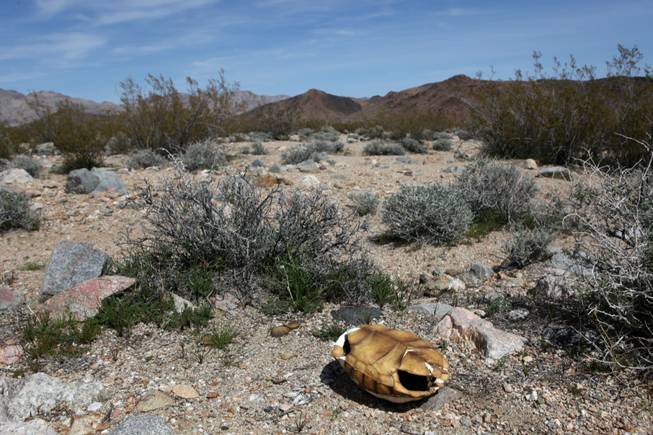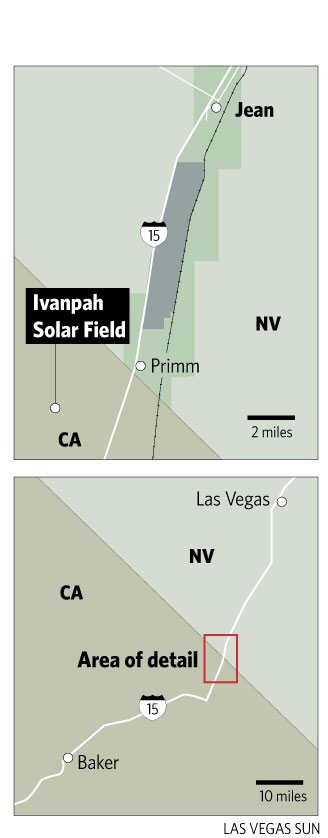
A tortoise shell lies on the desert floor south of Primm, where a solar power plant is expected to be built on 3,400 acres.
Tuesday, March 23, 2010 | 2:01 a.m.
Sun Archives
Sun Coverage
Some environmentalists are breaking ranks and fighting the solar industry.
The problem, as they see it, is that tens of thousands of acres of mostly pristine desert is slated for bulldozing to accommodate utility-scale solar power plants in Nevada and across the Southwest.
The solar plant planned 4.5 miles southwest of the Primm Golf Course, for example, will eat up about 3,400 acres. About 20 people hiked across several miles of that desert Saturday.
They’re members of the Sierra Club, the Center for Biological Diversity, the Western Watersheds Project, and Basin and Range Watch, but last weekend they were acting independently of their organizations. The hike was a form of protest. The mission was to gather information about rare and endangered plants and animals that live on the proposed site of the solar plant. The hikers’ plan is to use their knowledge of life on the site to block the development or at least force it to move.
Renewable energy developers have long been the darlings of environmental groups, but Saturday’s event highlights a growing rift within those groups. It’s not that the dissenters are anti-solar or anti-wind power. They simply want it to come in a form known as “distributed generation,” meaning rooftop solar panels and backyard wind turbines instead of massive new power plants and new transmission lines.
“I don’t understand why so much emphasis has to be put on these gigantic projects that are taking up wild open space,” hiker Laura Cunningham of Beatty says. “Reducing electricity consumption even a tiny bit and deploying urban technologies like rooftop solar first, before we start bringing out the bulldozers, would be better for everyone.”
Distributed generation requires no wilderness bulldozing, kills no animals and requires no massive infrastructure changes. It also has a smaller carbon footprint, according to RA Energie founder Herve Mazzocco, who has worked on renewable energy projects large and small.
Large utility-scale projects have larger carbon footprints for a number of reasons, he says. They tend to be built in remote locations and have to be huge in part because some of the electricity they generate is lost as the power is transported hundreds of miles along transmission lines. Adding to the carbon tally: Components are shipped from halfway around the world, and bulldozers and other equipment used to develop the land are polluters.
“Distributed generation systems can still be designed so the solar production coincides with the peak demand, which will save the utilities from running carbon intensive peak plants, there are no transmission losses as the energy is used on-site and, perhaps more significantly, there is no need for long environmental review processes, which means jobs right now, not in a year,” Mazzocco says.
A new workforce would be needed to manufacture and install the technology.
The government is pouring gargantuan subsidies into utility-scale renewable energy development. If it were to put that same kind of support into programs to help homeowners buy wholesale-cost solar panels and backyard wind turbines, it would preserve land and save tax dollars. Residents wouldn’t have to pay the added expense of funding huge renewable energy plants through increased electricity rates, advocates say.
But some say this corner of the renewable energy industry has been overlooked by the feds and state governments in favor of flashier utility-scale projects pushed by high-priced lobbyists and wealthy campaign contributors. The projects also make great backdrops for news conferences.
Groups such as Sierra Club are strong supporters of renewable energy development because of its potential to reduce carbon emissions. But many members of these groups are appalled at how the technology is being rolled out. If large plants must be built, why not build them on previously disturbed land such as capped landfills or in pockets of undeveloped land in the urban core, they ask.
They argue cities such as Las Vegas that developed in a hopscotch manner could actually benefit from solar plants infilling undeveloped areas surrounded by suburban sprawl.
“We just think it’s happening too fast,” Cunningham says. “There has been no planning from the government on where renewable energy should be built and how fast. There has been no discussion of how to balance the need for carbon-free electricity with massive environmental damage.”
Cunningham and fellow hikers say the Ivanpah Solar Field planned for just over the California state line south of Primm is a prime example.
The project is expected to be the first mega solar plant in the U.S. It was the first solar project to receive approval for a federally backed loan guarantee through the Energy Policy Act.
The Ivanpah array will be Oakland, Calif.-based BrightSource Energy’s first American plant. The company has several other projects planned, including one in the Coyote Springs development north of Las Vegas.
Construction on the Ivanpah project is expected to begin this year. It will employ about 1,000 union workers, most likely from nearby Primm and Las Vegas, at the height of construction.
The site is far from pristine, the developer says. It is crisscrossed with transmission lines and off-road vehicle trails.
As for the concerns that it will kill rare plants and destroy critical habitat of endangered desert tortoises, BrightSource says it will uproot many of the most important plants — which include ancient colonies of creosote bushes and centuries-old barrel cactuses as well as rare wildflowers and even invasive grasses — and either transplant them or keep them in a nursery for the estimated 30-year lease of the BLM acreage.
Desert tortoises would be moved. One in every six tortoises moved would die, according to the environmental impact statement.
The company has responded to government and private concerns about the location by downscaling to avoid the most sensitive areas.
Some environmentalists say it’s a decent solution for this site but fear it sets a dangerous precedent in the deserts of Southern Nevada and California, some of which have far more sensitive habitat than the BrightSource site, explains Kevin Emmerich, another Beatty resident and member of Basin and Range Watch.
So he and his fellow hikers were looking for Native American artifacts, counting endangered species and looking for engineering flaws in the project’s flood and fire mitigation plans to try to slow the process and convince the powers that be to take a different approach to the country’s clean energy future.


Join the Discussion:
Check this out for a full explanation of our conversion to the LiveFyre commenting system and instructions on how to sign up for an account.
Full comments policy